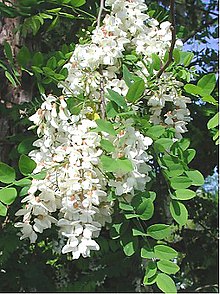| Black locust | |
|---|---|

| |
| Flowers | |
| Scientific classification | |
| Kingdom: | Plantae |
| Clade: | Tracheophytes |
| Clade: | Angiosperms |
| Clade: | Eudicots |
| Clade: | Rosids |
| Order: | Fabales |
| Family: | Fabaceae |
| Subfamily: | Faboideae |
| Genus: | Robinia |
| Species: | R. pseudoacacia
|
| Binomial name | |
| Robinia pseudoacacia | |

| |
| Native range | |
Robinia pseudoacacia, commonly known in its native territory as black locust,[3] is a medium-sized hardwood deciduous tree, belonging to the tribe Robinieae of the legume family Fabaceae. It is native to a few small areas of the United States, but it has been widely planted and naturalized elsewhere in temperate North America,[4] Europe, Southern Africa[5] and Asia and is considered an invasive species in some areas, such as the temperate east coast of Australia where the cultivar "Frisia" (Golden Robinia) was widely planted as a street tree before being classed as a weed.[6] Another common name is false acacia,[7] a literal translation of the specific name (pseudo [Greek ψευδο-] meaning fake or false and acacia referring to the genus of plants with the same name).
- ^ Contu, S. (2012). "Robinia pseudoacacia". IUCN Red List of Threatened Species. 2012: e.T19891648A20138922. doi:10.2305/IUCN.UK.2012.RLTS.T19891648A20138922.en. Retrieved 19 November 2021.
- ^ NatureServe (2024). "Robinia pseudoacacia". Arlington, Virginia. Retrieved 21 August 2024.
- ^ NRCS. "Robinia pseudoacacia". PLANTS Database. United States Department of Agriculture (USDA). Retrieved 22 October 2015.
- ^ "Robinia pseudoacacia". County-level distribution map from the North American Plant Atlas (NAPA). Biota of North America Program (BONAP). 2014.
- ^ "Robinia pseudoacacia". www.biodiversityexplorer.org. Archived from the original on 4 September 2018.
- ^ "Black Locust, False Acacia, Locust Tree, Yellow Locust, Robinia, White Acacia". Weeds Australia. Retrieved 30 October 2023.
- ^ BSBI List 2007 (xls). Botanical Society of Britain and Ireland. Archived from the original (xls) on 26 June 2015. Retrieved 17 October 2014.

